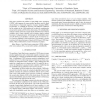Free Online Productivity Tools
i2Speak
i2Symbol
i2OCR
iTex2Img
iWeb2Print
iWeb2Shot
i2Type
iPdf2Split
iPdf2Merge
i2Bopomofo
i2Arabic
i2Style
i2Image
i2PDF
iLatex2Rtf
Sci2ools
103
Voted
ICASSP
2011
IEEE
2011
IEEE
Joint blind source separation from second-order statistics: Necessary and sufficient identifiability conditions
This paper considers the problem of joint blind source separation (J-BSS), which appears in many practical problems such as blind deconvolution or functional magnetic resonance imaging (fMRI). In particular, we establish the necessary and sufficient conditions for the solution of the J-BSS problem by exclusively exploiting the second-order statistics (SOS) of the observations. The identifiability analysis is based on the idea of equivalently distributed sets of latent variables, that is, latent variables with covariance matrices related by means of a diagonal matrix. Interestingly, the identifiability analysis also allows us to introduce a measure of the identifiability degree based on Kullback-Leibler projections. This measure is clearly correlated with the performance of practical SOS-based J-BSS algorithms, which is illustrated by means of numerical examples.
Blind Source Separation | ICASSP 2011 | Identifiability Analysis | Latent Variables | Signal Processing |
| Added | 21 Aug 2011 |
| Updated | 21 Aug 2011 |
| Type | Journal |
| Year | 2011 |
| Where | ICASSP |
| Authors | Javier Vía, Matthew Anderson, Xi-Lin Li, Tülay Adali |
Comments (0)

